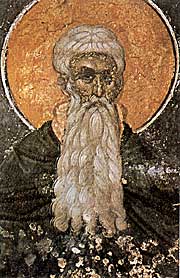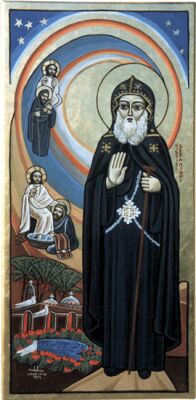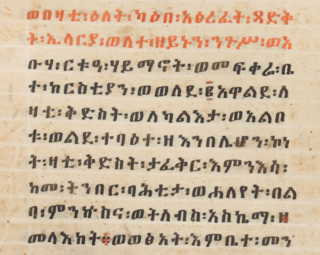Related Research Articles

Anthony the Great was a Christian monk from Egypt, revered since his death as a saint. He is distinguished from other saints named Anthony, such as Anthony of Padua, by various epithets: Anthony of Egypt, Anthony the Abbot, Anthony of the Desert, Anthony the Anchorite, Anthony the Hermit, and Anthony of Thebes. For his importance among the Desert Fathers and to all later Christian monasticism, he is also known as the Father of All Monks. His feast day is celebrated on 17 January among the Eastern Orthodox and Catholic churches and on Tobi 22 in the Coptic calendar.

Moses the Black, also known as Moses the Strong, Moses the Robber, and Moses the Ethiopian, was an ascetic monk and priest in Egypt in the fourth century AD, and a Desert Father. He is highly venerated in the Eastern Orthodox Church and the Oriental Orthodox Church. According to stories about him, he converted from a life of crime to one of asceticism. He is mentioned in Sozomen's Ecclesiastical History, written about 70 years after Moses's death.

Saint Simon the Tanner, also known as Saint Simon the Shoemaker is the Coptic Orthodox saint associated with the story of the moving the Mokattam Mountain in Cairo, Egypt, during the rule of the Muslim Fatimid Caliph al-Muizz Lideenillah (953–975) while Abraham the Syrian was the Pope of the Coptic Orthodox Church of Alexandria.

A skete ( ) is a monastic community in Eastern Christianity that allows relative isolation for monks, but also allows for communal services and the safety of shared resources and protection. It is one of four types of early monastic orders, along with the eremitic, lavritic and coenobitic, that became popular during the early formation of the Christian Church.

Saint Anastasia the Patrician was a Byzantine courtier and later saint. She was a lady-in-waiting to the Byzantine empress Theodora. Justinian I, Theodora's husband, may have pursued her, as Theodora grew jealous of her. Anastasia, to avoid any trouble, left for Alexandria in Egypt. She arrived at a place called Pempton, near Alexandria, where she founded a monastery which would later be named after her. She lived with monastic discipline and wove cloth to support herself.

Arsenius the Deacon, sometimes known as Arsenius of Scetis and Turah, Arsenius the Roman or Arsenius the Great, was a Roman imperial tutor who became an anchorite in Egypt, one of the most highly regarded of the Desert Fathers, whose teachings were greatly influential on the development of asceticism and the contemplative life.

Wadi El Natrun is a depression in northern Egypt that is located 23 m (75 ft) below sea level and 38 m (125 ft) below the Nile River level. The valley contains several alkaline lakes, natron-rich salt deposits, salt marshes and freshwater marshes.

The Monastery of Saint Macarius The Great also known as Dayr Aba Maqār is a Coptic Orthodox monastery located in Wadi El Natrun, Beheira Governorate, about 92 km (57 mi) north-west of Cairo, and off the highway between Cairo and Alexandria.

The Monastery of Saint Mary El-Sourian is a Coptic Orthodox monastery located in Wadi El Natrun in the Nitrian Desert, Beheira Governorate, Egypt. It is located about 500 meters northwest of the Monastery of Saint Pishoy.

The Monastery of Saint Anthony is a Coptic Orthodox monastery standing in an oasis in the Eastern Desert of Egypt, in the southern part of the Suez Governorate.
Abraham of Farshut was an abbot and is a saint of the Coptic Church, and by extension all of the Oriental Orthodox Churches. His feast day in the calendar of saints of the Coptic Church is February 12.
Venerable Zachariah the Recluse of Egypt was an Egyptian Christian monk who lived during the 4th century in Scetis, Lower Egypt. He is the patron saint of society's outcasts. He served the homeless and poor, and is remembered as a monastic father.

Abba Poemen the Great was a Christian monk and early Desert Father who is the most quoted Abba (Father) in the Apophthegmata Patrum. Abba Poemen was quoted most often for his gift as a spiritual guide, reflected in the name "Poemen" ("Shepherd"), rather than for his asceticism. He is considered a saint in Eastern Christianity. His feast day is August 27 in the Julian calendar.

Bishoy of Scetis, known in the Coptic Orthodox Church of Alexandria as the Star of the Desert and the Beloved of our Good Savior, was a Coptic Desert Father. He is said to have seen Jesus, and been bodily preserved to the present day via incorruptibility at the Monastery of Saint Bishoy in the Nitrian Desert, Egypt. He is venerated by the Oriental Orthodox Churches and the Eastern Orthodox Church, and is known in the latter under the Greek version of his name, Paisios.
The Forty-Nine Martyrs of Scetis were Christian monks of the monasteries of Scetis in Roman Egypt who were massacred by Berbers during a raid in 444. Two laymen were martyred along with them. Their relics lie in the Monastery of Saint Macarius the Great. They are venerated in the Coptic Orthodox Church, but not in the Eastern Orthodox or Roman Catholic churches.

The Legend of Hilaria is a Coptic romance, possibly a Christian version of the pagan Tale of Bentresh. It was written between the 6th and 9th centuries AD. During the Middle Ages, it was translated into Syriac, Arabic and Ethiopic. It tells the tale of Hilaria, daughter of the Roman emperor Zeno, who disguised herself as a man to become a monk and later heals her sister of an ailment. The tale was incorporated into the synaxaries of the Oriental Orthodox churches, and Hilaria came to be celebrated as a saint.
The Life of Saint Apolinaria is a legendary Greek saint's life. It is about a transvestite virgin girl living as a monk in the desert of Scetis in Egypt. It is the Greek counterpart to the Coptic Legend of Hilaria.
Isaiah the Solitary, also known as Isaiah of Gaza, Isaias the Solitary, Abba Isaiah, or possibly also Isaiah of Scetis, was a Christian ascetic and monastic writer known from the Sayings of the Desert Fathers and various Palestinian Miaphysite sources. He is canonized as a saint by the Coptic Orthodox Church, with his feast day on the 11th day of the month Abib (Epip) in the Coptic calendar.
Mount Colzim, also known as the Inner Mountain of Saint Anthony, is a mountain in Red Sea Governorate, Egypt. It was the final residency of Anthony the Great from about AD 311, when he was 62 years of age, to his death in 356.
Paremhat 30 – Coptic calendar – Parmouti 2
References
- ↑ The Book of the Saints of the Ethiopian Church, p. 474, CUP Archive
- ↑ Holweck, F. G. A Biographical Dictionary of the Saints St. Louis, MO: B. Herder Book Co. 1924. p. 5
